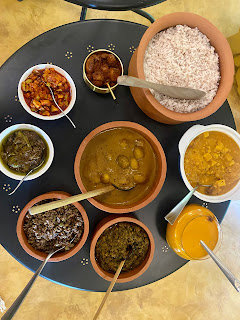Shubhra Shankhwalkar and preserving the history of a community through food
Shubhra is probably the most important custodian of Saraswat Brahmin cuisine in the world today. While there are some restaurants that do serve Saraswat food and do it well, they are very few and most of them are based on the personal kitchen of a single person, usually a mother or grandmother, and her memories. The other challenge the restaurants face is that they need to function within the construct of a commercial kitchen which means they can’t follow the rhythms of an actual household when it comes to things like seasonality, daily market availability or hyper local produce.
What Shubhra does at her farm is a meal for a smaller group that doesn’t have a pre-planned menu but is derived from what is available in the market on the day or the week. The traditional Saraswat home kitchen is based on the rhythms of the local market and so every meal at Shubhra’s farm is a voyage of discovery, learning and adventure. We got to have vegetables that included mangrove ferns, teasel gourd and hog plum that are unfamiliar to most of us. Even a dish like solkadi, which we thought we knew well and thought of as a homogeneous dish, takes on five different forms in Shubhra’s farm. The season impacts the colour, taste and texture of a solkadi as well as when in a meal you have it, showing a versatility and adaptability that most of us are unaware of.
This kind of knowledge is based on a depth of research that is unparalleled. Shubhra has researched and written down over a thousand recipes, not just from her own mother and grandmother but from different relatives, in-laws, aunts, cousins and even friends from the community. This means that she is able to identify, preserve and highlight things as nuanced as how Vaishnavite and Shaivite communities use different condiments for the same meals or emphasise different flavour profiles for a fish curry with the same name.
We have moved into a world where there is this commodified idea of Goan cuisine filled with cliches and stereotypes. Even when people explore Saraswat food, the approach is often reductive and you end up with Kokum and coconut based prawn and fish curries or rava fried dishes. Everything is simplified for easy consumption.
Shubhra’s food is as far from commodification as it’s possible for anyone to get. She revives and cooks dishes that many people haven’t ever eaten for decades (and in some cases more than half a century) with only the memories of aged grandparents in the community to guide her on both recipe and flavour. But the results end up being unique and eye opening, like a karela raita which has no curd because curd was never a part of Goan cuisine. Similarly, while the meal does include meat dishes, it only serves chicken occasionally because chicken was never a meat cooked in Saraswat households and any chicken recipes that exist have only emerged in the last few decades.
The work that Shubhra is doing is hugely important. She is using food to preserve the traditions, habits and culture of a small community that in many ways is battling the tides of time and change and losing its singular way of life. This is a work of historical and cultural archiving in lived form, and my only plea is that someone steps up and helps her document this physically, in words and pictures, on the page and on the screen, so this precious legacy is passed on to future generations.
We ate:
Akurche Tonak with prawns: Curry made of Mangroves ferns- Kalunderache Hooman: Pearl spot fish curry
- Chicken Xacuti
Amyache ani Ansache Tonak: Mango pineapple curry
Ambadyachi Uddamethi: Hog plum curry- Kelphulachi Bhaji : Bhaji made of banana flower
- Karatyache Raite: Karela raita
Phaglachi Fodi : Teasel gourd rawa fry
Barille Bangde : Stuffed mackerel
Goan Red Rice
Sol kadi- Home made Pickle
- Rice Vade
Kangachyo Nevryo: Sweet potato dumplings- Shirvyo : Rice noodles with sweetened coconut milk


















Comments